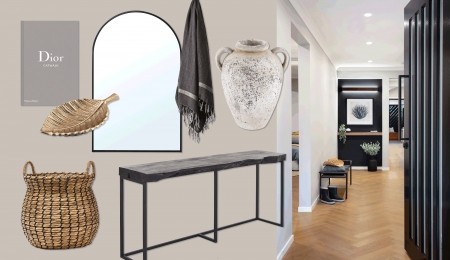How to Choose the Right Type of Flooring
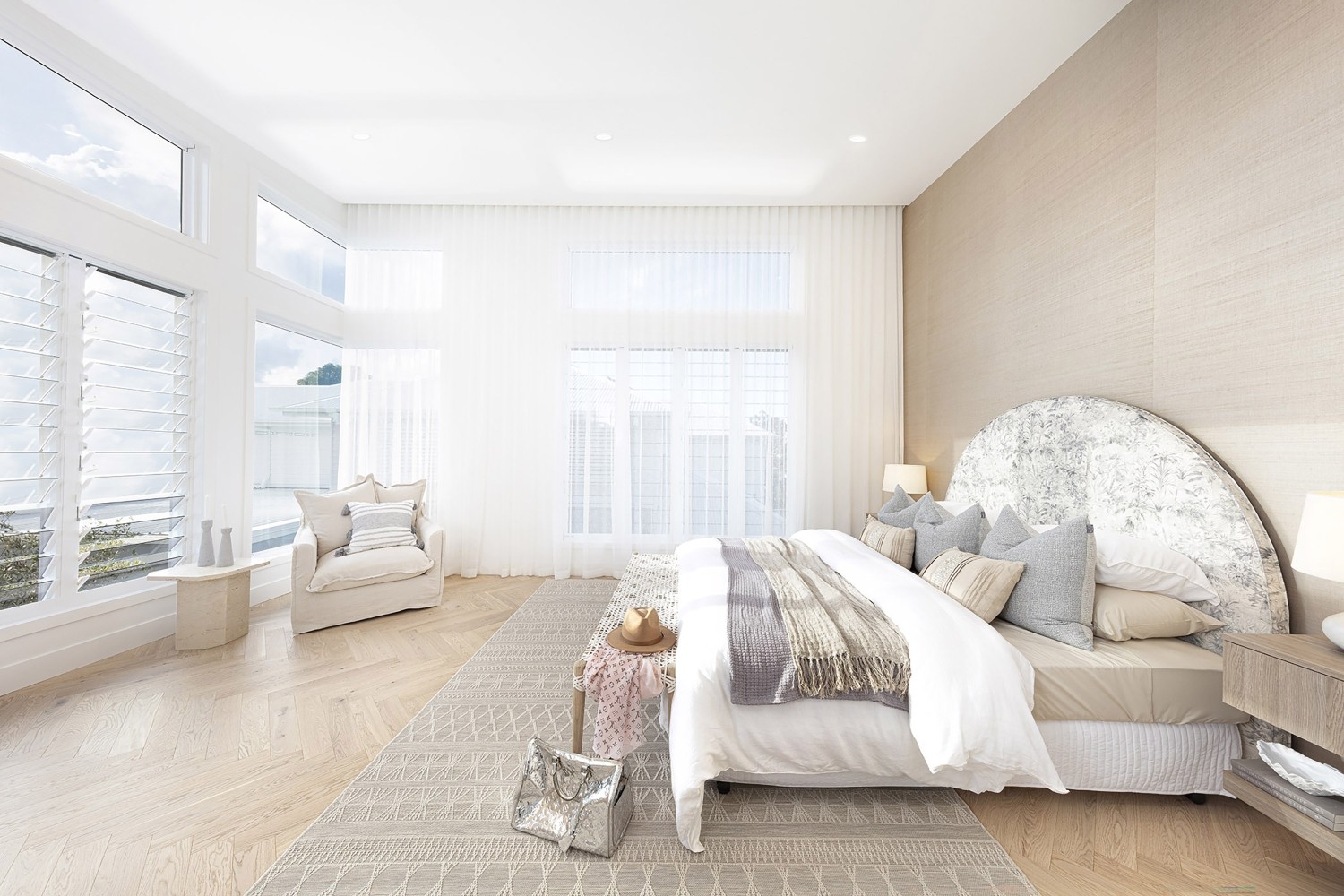
Choosing the best types of flooring for different parts of your home might not seem like a challenging task, but it can get overwhelming given the sheer amount of options available to you. That’s why it's essential to weigh the pros and cons of each material, and consider how certain factors – like their durability and aesthetic appeal – will impact your day-to-day home life.
Whether you're wondering which flooring is best for a kitchen or seeking durable flooring options for pets, we’re here to help you make the most informed decision for your property.
What to Consider When Choosing Flooring for Your Home?
When you start to look into the different types of flooring for your own home now, the initial visual appeal and cost factor may be the biggest factors of which flooring is best. But you’ll also want to consider the long-term liveability and functionality of the flooring material.
Durability is key. Different areas of your home are likely to experience different levels of foot traffic – the main hallway, for example, will get much more use than the guest bedroom. So thinking about choosing a flooring material that can withstand daily wear and tear. Also factor in the ease or difficulty of maintaining the flooring. Some materials are more high-maintenance and require regular cleaning and upkeep.
If you have pets or kids, you’ll also need to think about which flooring is best for pets and which materials can withstand everyday dirt and grime that children pick up. Look for the types of flooring that are scratch-resistant and easy to clean. Moisture and stain-resistance materials are also worth considering for spaces like the kitchen and bathrooms.
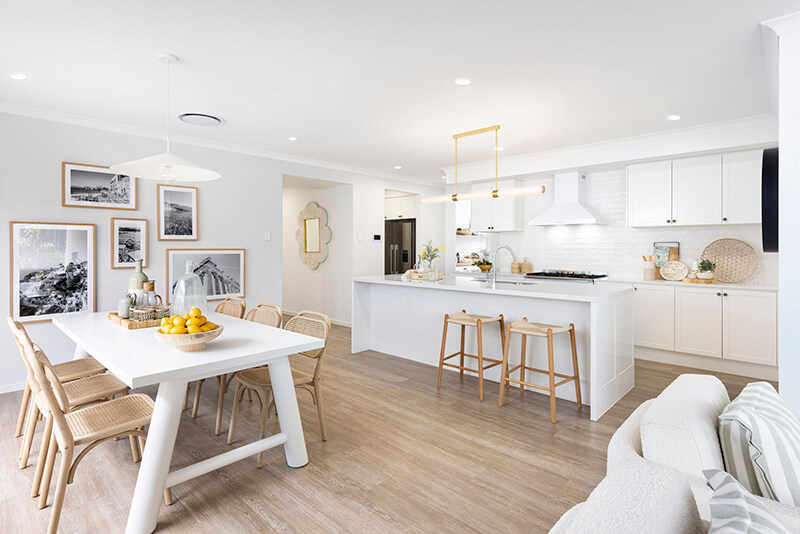
Know Your Flooring Materials
Carpet
Best Suited For: Families with kids; Cost-conscious homeowners
Carpet flooring has been a staple of Australian homes for generations. It’s a soft and comfortable surface to walk on, and it’s available in a massive range of colours, styles and textures. In other words, carpet is great for homeowners who want a material that matches their unique design preferences.
In terms of cleaning and upkeep, regular vacuuming is necessary to remove dirt, dust and allergens that can build up in the carpet fibres. Professional deep cleaning might also be necessary every year or two in order to protect the carpet's appearance and prolong its lifespan. Spills and stains do happen from time to time, and with carpet you’ll need to blot them with a clean cloth and using specific carpet-cleaning products. Some carpets do come with stain-resistant treatments that can make cleaning easier.
Also consider carpet in terms of the furniture that will be placed on top of it. It’s recommended that you use furniture pads to prevent permanent indentations from forming on the carpet. Ultimately, proper maintenance and knowing how to clean floors with carpet can help keep it looking fresh and vibrant for years to come.
Benefits:
- Comfort: Carpet has a soft and cosy surface to walk on, ideal for bedrooms and other places dedicated to comfort.
- Warmth: Carpet has insulating properties, which means rooms can stay warmer and better insulated during winter.
- Noise reduction: Carpet helps absorb and reduce noise, making it an excellent choice for bedrooms and living rooms.
- Safety: The cushioned nature of carpet is not only soft underfoot, but it makes it a safer option in case of slips and falls, especially for homes with young children or elderly family members.
Disadvantages:
- Staining and spills: Carpet is more prone to staining and spills compared to other flooring materials. It demands immediate attention and proper cleaning products to avoid permanent staining.
- Maintenance and cleaning: Carpet needs regular upkeep, including vacuuming and periodic deep cleaning, to keep it looking clean and fresh. This can be time-consuming and expensive.
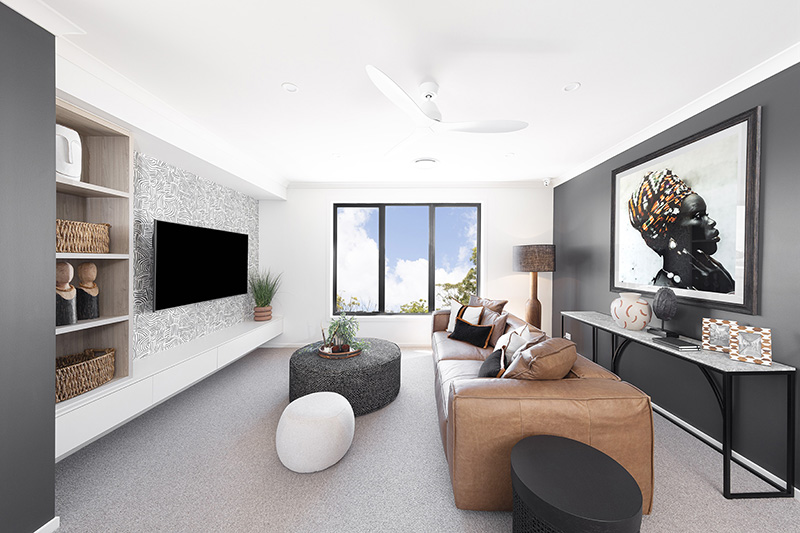
Vinyl Flooring
Best Suited: Pet-friendly families; High traffic areas
Vinyl flooring is made up of multiple layers, including a resilient vinyl core, a printed design layer and then a protective wear layer on top. The way vinyl is constructed means you’ll get a durable floor that’s resistant to scratches, stains and moisture.
Maintaining vinyl flooring is relatively simple. Daily sweeping or vacuuming will get rid of loose dirt, while mopping with a gentle cleaner can eliminate stains easily. Just make sure you avoid using harsh or abrasive cleaning products as they can damage the surface.
Benefits:
- Durability: Vinyl flooring can withstand heavy and constant foot traffic, making it ideal for busy homes.
- Water resistance: Water-resistant or even waterproof, depending on the specific type of flooring used, vinyl is a good choice in moisture-prone areas like kitchens and laundry rooms.
- Easy maintenance: It’s relatively low-maintenance and easy to clean. Sweeping or vacuuming, as well as mopping, is usually all you’ll need to do to keep it looking great.
Disadvantages:
- Susceptible to scratches: While vinyl flooring is generally durable, it can still get scratched from sharp objects or heavy furniture.
- Fading issues: Over time, vinyl flooring can start to fade or discolour if it’s regularly exposed to sunlight. However, this is less likely to occur with higher-quality vinyl options.
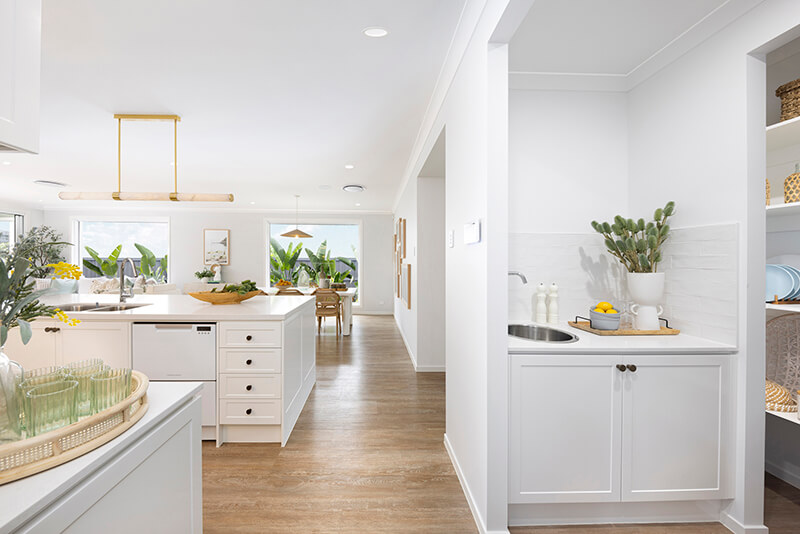
Laminate Flooring
Best Suited: Active families with pets; Allergy sufferers
An affordable and low-maintenance option that mimics the look of natural materials like hardwood and stone, laminate is another popular flooring option in busy households.
Cleaning and maintaining laminate flooring is relatively easy. Sweeping or vacuuming with a soft brush attachment will remove any dirt, while mopping with a mild, non-abrasive cleaner is usually sufficient for deeper cleans. Be careful of excessive mopping though, as laminate isn’t waterproof and moisture can seep into the joints and cause damage.
Benefits:
- Affordability: Laminate flooring is an affordable alternative to natural materials like solid timber flooring, reclaimed wood or stone.
- Durability: It’s a highly durable flooring option and is resistant to scratches, stains and fading. It can stand up to the wear and tear of daily life, making it a practical choice for high traffic areas and active households.
- Easy installation: Laminate flooring is designed for easy installation, particularly with click-and-lock systems. So if you’re a DIY enthusiast it can help you save on installation costs.
Disadvantages:
- Moisture issues: Laminate flooring is susceptible to moisture damage. While it has some resistance to water, excessive moisture exposure can cause warping, swelling or delamination of the planks.
- Limited repair options: Unlike solid wood flooring, which can be sanded and refinished multiple times, laminate flooring can’t be refinished. If it gets damaged or overly worn, the only solution is to replace the affected planks or the entire floor.
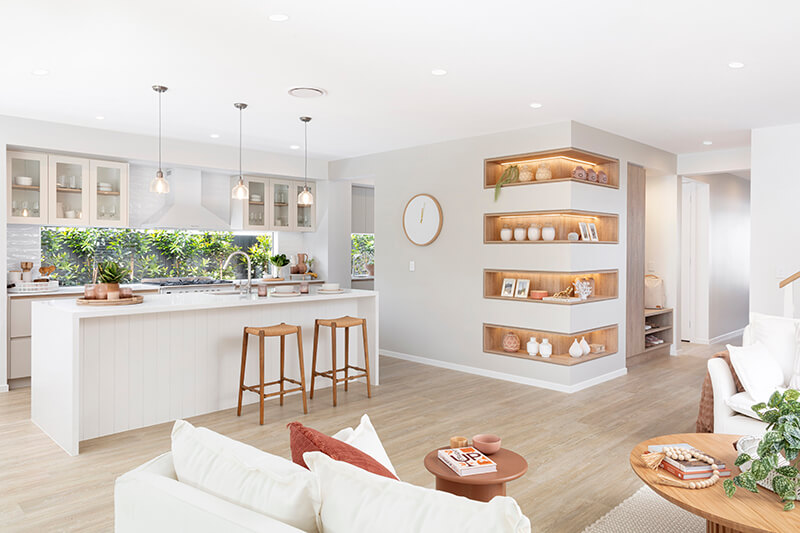
Hardwood Flooring
Best Suited: Low-maintenance homeowners; Resale value
Hardwood flooring is a classic and timeless choice that adds natural beauty and warmth to any home. It’s made from real wood, which means it’s an extremely durable and long-lasting flooring option. Materials like solid timber floors can be refinished multiple times, allowing for full restoration and taking care of any scratches or damage that may occur over the years.
It's important to protect your hardwood floors from moisture and scratches by using furniture pads and rugs. With proper care and upkeep, wood flooring can last for generations.
Benefits:
- Timeless beauty: Something like solid timber floors offers a timeless and natural beauty that enhances the aesthetic appeal of any space.
- Durability and longevity: Hardwood floors are known for their durability and can last for decades or even a lifetime with proper care and maintenance.
- Increased resale value: Wood flooring is highly sought after and can significantly increase the resale value of your home – so consider it a valuable investment.
Disadvantages:
- Higher cost: Wood flooring tends to have a higher upfront cost compared to other flooring options, so it’ll require a larger initial outlay.
- Susceptible to scratches: Solid hardwood flooring can be prone to scratching and denting, particularly in busy areas or when you have indoor pets.
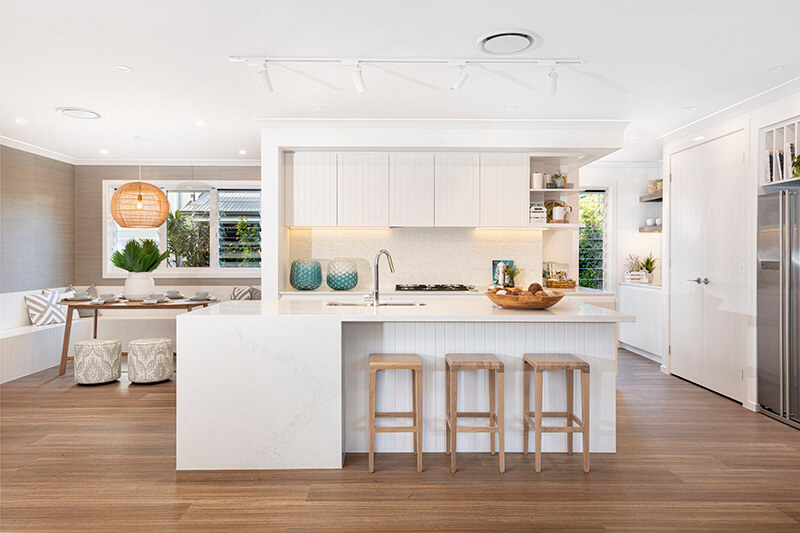
Tiles:
Best Suited: High-traffic areas; Allergy sufferers
It’s easy to take care of tile floors with a quick vacuum followed by mopping with a mild cleaner. You may need to reseal the grout lines every few years to help maintain their appearance and protect against staining.
Benefits:
- Durability: Tiles are highly durable and scratch-resistant, making them the perfect addition to hallways, kitchens and outdoor entertainment areas.
- Low maintenance: Tile floors need very little maintenance, so they are perfect for households that don’t want to have to worry about constant cleaning.
- Design versatility: Tile flooring comes in a wide range of designs and styles, so you can easily create that unique, custom look you’ve been dreaming about.
Disadvantages:
- Cold surface: Tile flooring can feel cold and uncomfortable to walk on, especially during the colder months.
- Hardness: The hard surface of tile flooring can be unforgiving on joints and may even cause discomfort when standing for long periods.
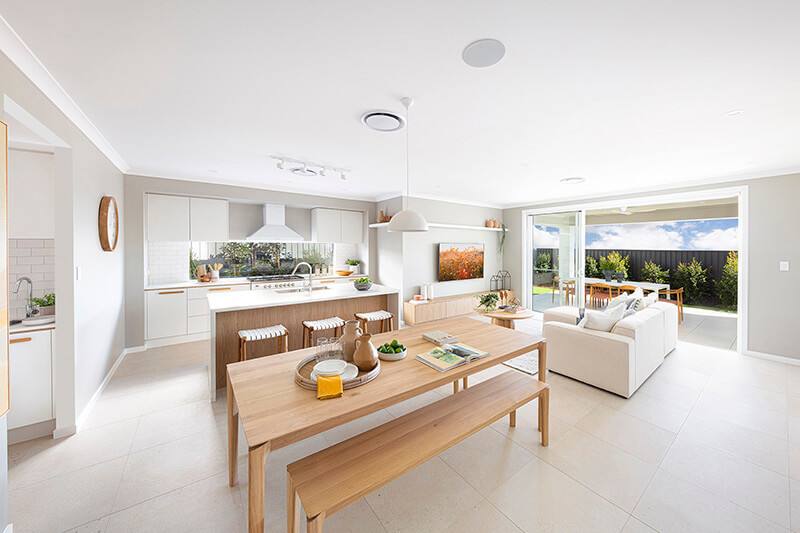
Engineered Flooring
Best Suited: Sustainability-conscious homeowners; Spaces prone to moisture
Engineered wood flooring is a stylish flooring option that gives you the look of hardwood with added stability and moisture resistance. It’s constructed with a real wood veneer layer on top, which gives the desired aesthetic of hardwood, as well as a layered core made of plywood or composite materials.
Cleaning and maintaining your engineered wood flooring is similar to how you would look after solid hardwood, including regular sweeping or vacuuming and the occasional mopping.
Benefits:
- Aesthetic appeal: Engineered flooring has the look and beauty of hardwood, while also providing a warm and natural feel to any space.
- Stability and moisture resistance: The layered construction makes for very resilient flooring that is less prone to warping.
Disadvantages:
- Limited refinishing: The thickness of the real wood veneer layer determines the number of times it can be sanded down and refinished.
- Expensive: Engineered flooring is typically more expensive than laminate or vinyl options. It also may not have the same long-term value or lifespan as something like solid timber floorboards or even concrete flooring.
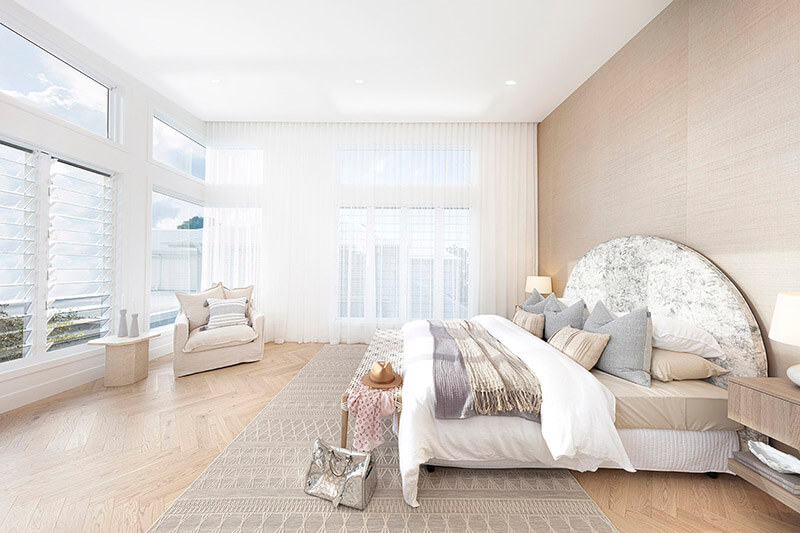
Hybrid Flooring
Best Suited: Busy households; Style-conscious homeowners
Hybrid flooring combines the best features of different flooring materials. It’s typically made up of multiple layers, with a rigid core of stone composite or SPC (stone plastic composite), a printed design layer and a protective wear layer on top.
The good news is that hybrid flooring is easy to clean and maintain, with a light sweep or vacuum to take care of any dirt and grit. It can also be mopped with a mild cleaner whenever necessary.
Benefits:
- Durability: Hybrid flooring is highly durable and resistant to scratches and wear-and-tear.
- Water resistance: It’s designed to be waterproof or at the very least highly water-resistant, which protects against spills and potential water damage.
- Style versatility: Hybrid flooring comes in all sorts of designs – which means lots of colours, patterns and textures to choose from. It can very easily mimic the look of natural materials like a hardwood floor or stone flooring.
Disadvantages:
- High price point: While it’s durable and water-resistant, the initial outlay may be not be worth it for homeowners on a budget.
- Can’t refinish: Unlike solid hardwood flooring, hybrid flooring can’t be refinished. Once the wear layer is damaged or worn, the entire plank may need to be replaced.
Want to Find the Perfect Flooring for Your New Brighton Home?
At Brighton Homes, we understand that choosing the perfect type of flooring for your new home is an important – and sometimes challenging – process. That's why our MyChoice Design Studio offers open-studio sessions. You can explore and revisit the studio as often as you like prior to your selections appointment. Our experienced interior design consultants will then guide you through the process, helping you put together ideas and choose the ideal flooring for your home.
Whether you're seeking the timeless beauty of hardwood, the durability of tile or the affordability of laminate, we have a wide range of options to help you find the best type of flooring for your new Brighton Home.



